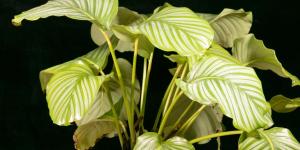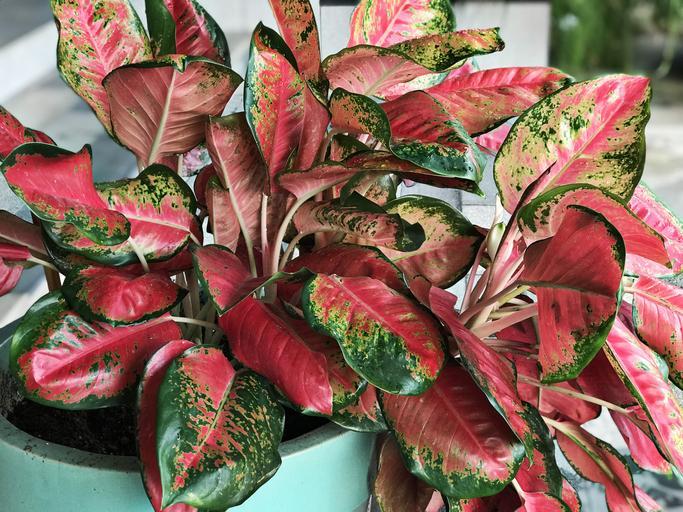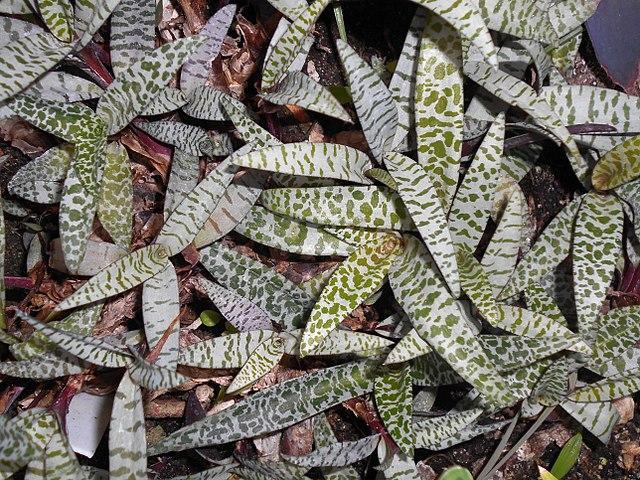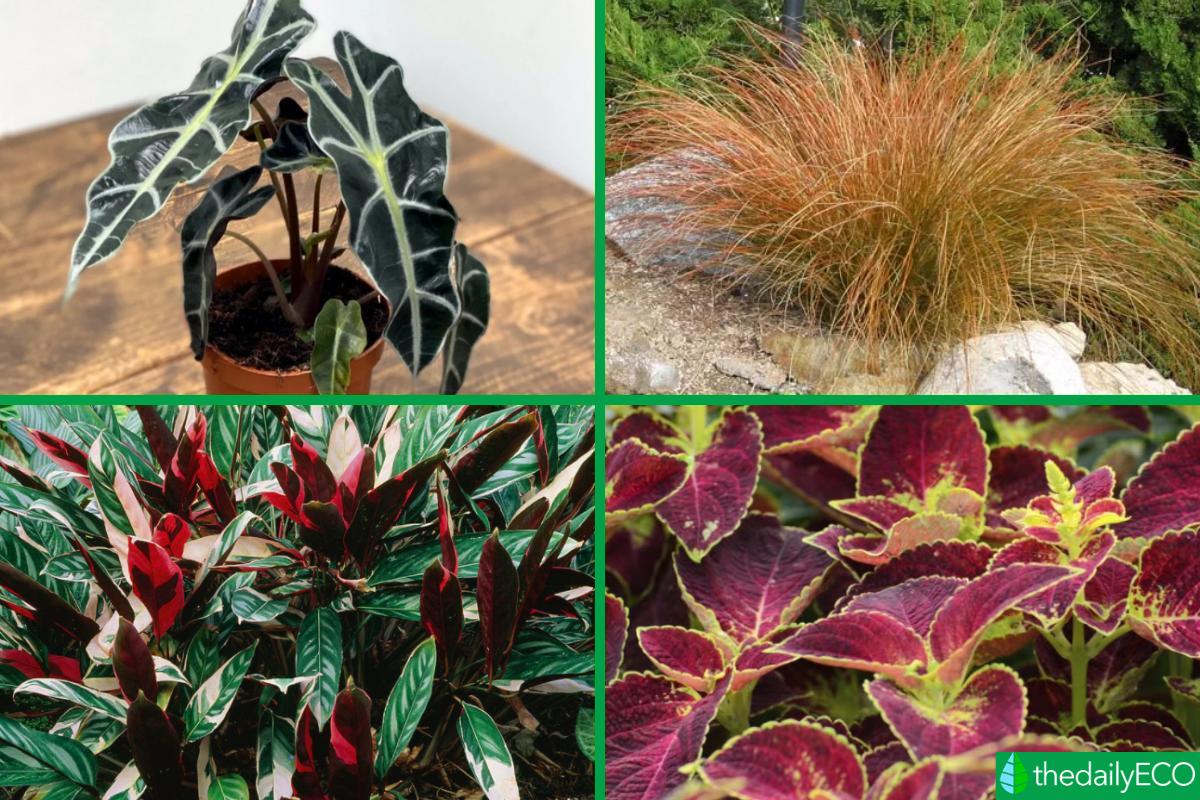Plants With Colorful Leaves - Bright Foliage Plants


Although we associate plant leaves with being green, some of the most beautiful foliage on our plant comes from plants with colorful leaves. These plants may incorporate green, but they also use a wide range of colors which we do not always associate with the leaves of plants. We know there are flowers with all the colors of the rainbow, but the leaves of different plant species tend to be a little more limited. Even so, there are plants with blue, red, purple, yellow and many other colors of leaves. Many also have incredible patterns which incorporate these colors.
thedailyECO provides 24 plants with colorful leaves and bright foliage to help give you an idea of the great diversity of plants. We provide names and descriptions of these plants, as well as photos so you can see their beauty up close.
- Why do plants have colorful leaves?
- Chinese evergreen (Aglaonema modestum)
- King begonia (Begonia rex)
- Calathea (Calathea)
- Indian shot (Canna indica)
- Rubber fig (Ficus elastica)
- Red ivy (Strobilanthes alternata)
- Bird's-nest fern (Asplenium nidus)
- Silver quill (Ledebouria socialis)
- Elephant ear (Caladium)
- American taro (Xanthosoma sagittifolium)
- Other plants with colorful leaves
Why do plants have colorful leaves?
The great biodiversity of different plant species has allowed for leaves and flowers to present in a wide range of colors. The reason for this is thanks to different natural pigmentations which can be found within the cells of plants. Different pigments have different uses, depending on the needs of the plant. While it may seem like the designs of plant leaves are arbitrary, they all exist for a purpose, even if we do not yet know the specifics of this purpose.
To better understand why plants have colorful leaves, we can look at the different types of pigments they can contain:
- Chlorophyll: this is the green pigment which is found in all plants. Different types of chlorophyll are also found in the chloroplasts of algae and in cyanobacteria. It is vital for the process of photosynthesis, allowing the plant to absorb energy from light. The reason it displays green is because it absorbs other wavelengths of light such as red and blue, reflecting the green back. Learn more with our guide to what are cyanobacteria in biology?
- Carotenoids: these are also useful in the process of photosynthesis, being used to absorb light energy and protect the structures of the plant. They provide yellow, red and orange coloration.
- Anthocyanins: these are water-soluable pigments which result in blue and purple pigmentations, some of which even appear to be black. They are a type of flavonoid which appear in all tissues of vascular plants. See anthocyanins at work with our guide to plants with black flowers.
- Betalains: responsible for red and yellow pigments. They are also water-soluable, but they do not appear in all vascular plants. They are known to be found in some plants such as cacti, a type of xerophyte plant.
These pigmentations absorb and reflect light in different ways, resulting in the colorful foliage of different plants. Below, we look at these pigments in action with our list of 24 plants with colorful leaves and their photos.
Chinese evergreen (Aglaonema modestum)
As its name suggests, the Chinese evergreen is a plant which has green leaves. These leaves are usually variegated, meaning they have more than one color. However, there is a variant which has red leaves as part of this variegation. There are even some with silvery colorations. This is an easy-to-grow plant as it needs relatively little maintenance, but it is a beautiful perennial which can be enjoyed throughout the year.

King begonia (Begonia rex)
Although the begonia is itself a plant already highly valued for its elegant flowers, the begonia rex variety has very characteristic colored leaves. As you can see in the photo below, they are large and rosette-shaped, presenting different patterns and colors from pink to deep purple. This plant prefers cool environments, with a high degree of humidity and does not receive direct light to improve its growth and flowering.
The begonia is just one of the many different types of spring flower bulbs you can enjoy in your garden.

Calathea (Calathea)
Another plant with colorful leaves is the calathea, sometimes known as the prayer plant. The leaves are large and colorfully patterned, presenting in different shapes depending on the variety. The leaves of this colorful plant are often variegated green on top and a reddish purple on the bottom, as you can see in the photo below. To help it stay healthy you will need to make sure it receives indirect light and abundant watering during spring and summer.

Indian shot (Canna indica)
Known for its beautiful tropical flowers the Indian shot, African arrowroot or edible canna is also known as a plant of great ornamental value thanks to the coloration of its leaves. These large leaves can have different shades ranging from green to red. Some variants have different patterns such as striped leaves with two colors. Like some of the other species of plants with colorful leaves, the Indian shot needs water and sun to favor its development. For this reason, it is often grown nears ponds or other water features.

Rubber fig (Ficus elastica)
One of the most used plants to decorate exteriors is the Ficus elastica or the rubber fig. Its reddish leaves stand out, but only during its first stage. They then deepen and become purple until an intense green color results in the adult plant. They prefer a bright environment, but without receiving direct sunlight. As long as you keep the substrate well drained, you will not have to worry about its care so that it always looks in perfect condition.
Color is not the only important feature of a plant's leaves. Learn more with our guide to the parts of a leaf and their functions.

Red ivy (Strobilanthes alternata)
Another of the most well-known plants with colorful leaves is red ivy which is native to Asia. As with the calathea, they have green upper parts of the leaf, but a reddish underside. Their leaves are also serrated. Their coloration is determined by the temperature of the environment and the light they receive, becoming almost metallic when very warm. It is best kept outdoors, but can be used as an indoor plant if cared for properly.
Learn about other plants to grow inside with our guide to the best aromatic indoor plants.

Bird's-nest fern (Asplenium nidus)
This curious species of tree fern is native to Australia and Malaysia. Due to its natural habitat, it also needs adequate humidity conditions for optimal growth. If you take care of it carefully, it can be an exceptionally long-lived plant. In addition, the large wavy leaves of the Asplenium nidus which are apple green in color with purple veins can reach more than 50cm in length. A perfect option to decorate your home with a unique and natural touch.

Silver quill (Ledebouria socialis)
This bulbous plant of the Asparagaceae family is typical of South Africa. It has variegated leaves on the upper side and purple on the underside. In addition to its rare and beautiful leaves, its flowers are very showy, despite their relatively small size. It can be kept in a shady place. Also some of the plants have vibrant colorful leaves, the silver quill has beautiful silvery bright foliage with green spotted patterns.

Elephant ear (Caladium)
This plant with colorful leaves has different common names, including heart of Jesus and angel wings. It is a genus of plants, rather than one individual variety. Their unique color combinations depend on these varieties and include green, white, red and even pink. Plants from Caladium are annual plants that are perfect for decorating interior spaces since they do not tolerate frost well and prefer not to receive direct sunlight.

American taro (Xanthosoma sagittifolium)
Although this plant is also known as the arrowleaf elephant ear, it is one of the plants with bright foliage which is part of a different genus. If you want a tropical touch to your home or garden, we recommend this plant with its large, pointed leaves. They also present a beautiful variegated pattern with white or yellow, perfect for various decors. They are one of the largest plants with colorful leaves on our list and can grow unique tubular inflorescences which can add to the exotic scene.

Other plants with colorful leaves
You have seen in the photos above some of the best plants with bright foliage, but there are many more in nature. We provide just a sample of some of them with the list below and the corresponding photos underneath:
- Alocasia Polly (A. × amazonica)
- True sedges (Carex)
- Giant bamburanta (Ctenanthe oppenheimiana)
- Coleus (Coleus blumei)
- Ti plant (Cordyline fruticosa)
- Fire croton (Codiaeum variegatum)
- Purple passion (Gynura aurantiaca)
- Prayer plant (Maranta leuconeura)
- New Zealand flax (Phormium)
- Sweet potato (Ipomoea Batatas)
- Silver spurflower (Plectranthus argentatus)
- Aluminum plant (Pilea cadierei)
- Persian shield (Strobilanthes dyerianus)
- Silver inch plant (Tradescantia zebrina)
Now you know some of the best plants with colored leaves to develop at home, you might want to think of some other types of plants to add to them. Learn what these might be with our articles on the best ornamental plants for the home and plants with bell-shaped flowers.




If you want to read similar articles to Plants With Colorful Leaves - Bright Foliage Plants, we recommend you visit our Plant care and cultivation category.



















